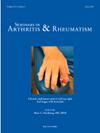An analysis of the first relapse in giant cell arteritis using ultrasonography
IF 4.6
2区 医学
Q1 RHEUMATOLOGY
引用次数: 0
Abstract
Objectives
To compare the nature of the first relapse of giant cell arteritis to baseline disease using ultrasonography
Methods
Patients with suspected new and relapsing giant cell arteritis between January 2017 and December 2023 underwent protocolised ultrasonography to examine the superficial temporal and axillary arteries plus other areas as clinically indicated. The nature of disease was categorised as affecting superficial temporal, axillary or mixed disease. Patients where other arteries were needed for diagnosis or relapse were categorised separately. Patients with clinically and sonological evidence of polymyalgia rheumatica were distinctly categorised.
Results
66 patients were included. At diagnosis and first relapse, 48/66 and 20/66 patients respectively had superficial temporal artery involvement. At diagnosis and first relapse, 23/66 and 40/66 respectively patients had axillary artery involvement. Patients without superficial temporal artery disease at diagnosis did not relapse in the superficial temporal artery. 7/66 patients suffered a polymyalgia rheumatica relapse. 5 of those 7 had superficial temporal arterial involvement at diagnosis.
Conclusion
This is the first study that reports on the nature of relapsing giant cell arteritis using sonological appearances. Relapsing disease is more common in the extracranial arteries and may be mistaken for polymyalgia rheumatica. True polymyalgia rheumatica relapses are uncommon. Relapses in patients with giant cell arteritis should be assessed using ultrasonography and should include the imaging of the axillary artery.
求助全文
约1分钟内获得全文
求助全文
来源期刊
CiteScore
9.20
自引率
4.00%
发文量
176
审稿时长
46 days
期刊介绍:
Seminars in Arthritis and Rheumatism provides access to the highest-quality clinical, therapeutic and translational research about arthritis, rheumatology and musculoskeletal disorders that affect the joints and connective tissue. Each bimonthly issue includes articles giving you the latest diagnostic criteria, consensus statements, systematic reviews and meta-analyses as well as clinical and translational research studies. Read this journal for the latest groundbreaking research and to gain insights from scientists and clinicians on the management and treatment of musculoskeletal and autoimmune rheumatologic diseases. The journal is of interest to rheumatologists, orthopedic surgeons, internal medicine physicians, immunologists and specialists in bone and mineral metabolism.

 求助内容:
求助内容: 应助结果提醒方式:
应助结果提醒方式:


